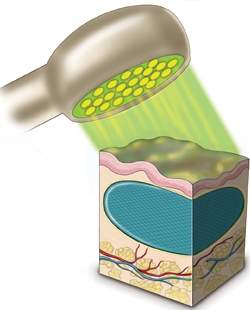 |
| O material, um composto de moléculas biológicas e sintéticas, é injetado em forma líquida sob a pele e curado com luz, adquirindo o formato definitivo. |
Reconstituição de tecidos
Engenheiros biomédicos desenvolveram um novo material líquido para substituir tecidos moles do corpo humano danificados em lesões muito graves.
Nos primeiros experimentos, já realizados in vivo, o material se mostrou promissor no restabelecimento dos tecidos moles danificados, sobretudo por ser muito duradouro.
O material, um composto de moléculas biológicas e sintéticas, é injetado sob a pele.
Em seguida, ele é curado usando a luz para formar uma estrutura mais sólida - de forma semelhante a usar o frio da geladeira para dar a consistência final a uma gelatina.
Compósito biológico-sintético
"Materiais biológicos implantados podem imitar a textura do tecido mole, mas geralmente eles são dissolvidos pelo próprio corpo rápido demais, enquanto os materiais sintéticos tendem a ser mais permanente, mas podem ser rejeitados pelo sistema imunológico e, normalmente, não se fundem bem com os tecidos circundantes naturais," explica Jennifer Elisseeff, da Universidade Johns Hopkins, nos Estados Unidos.
"Nosso material compósito tem o melhor dos dois mundos, com o componente biológico aumentando a compatibilidade com o corpo, e o componente sintético contribuindo para sua durabilidade."
Os pesquisadores criaram o material compósito usando ácido hialurônico, um componente natural que dá elasticidade à pele, e polietileno glicol (PEG), uma molécula sintética usada como cola cirúrgica e bem conhecido por não causar reações imunológicas graves.
O PEG forma ligações químicas resistentes e intercruzadas entre muitas moléculas individuais, aprisionando com ele as moléculas de ácido hialurônico. Essa reação é induzida pela luz.
Essas ligações cruzadas mantêm o formato do implante, evitando que ele fuja do local onde é aplicado.
Reconstrução da face
Os pesquisadores advertem que o novo material, descrito em um artigo na revista Science Translational Medicine, é "promissor", mas ainda não está pronto para uso clínico.
"Ainda temos de avaliar a persistência e a segurança do nosso material em outros tipos de tecidos humanos, como músculos ou regiões menos adiposas sob a pele do rosto, para que possamos otimizá-lo para procedimentos específicos", diz Elisseeff.
Elisseeff disse que a equipe está particularmente esperançosa com o uso do novo compósito em pessoas com deformidades faciais graves, que sofrem trauma social e psicológico.
Na reconstrução de tecidos moles, a recriação da forma natural, sobretudo do rosto, muitas vezes requer múltiplas cirurgias e pode resultar em cicatrizes.

